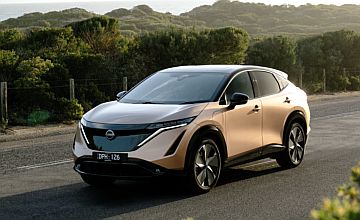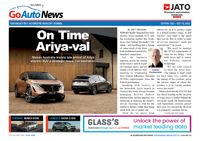Make / Model Search
OptionsCar reviews - Nissan - AriyaNissan modelsOverviewWe like Stylish presentation inside and out; ease of use and straightforward HMI; very good ADAS calibration; exceptionally quiet cabin; generous warranty and aftersales support; reasonable real-world driving range Room for improvement Tighter rear seat space; average acceleration of 2WD; questionable benefits of sliding console and open front floor; price point against nearest rivals; uneasy rear suspension tune; firm ride on larger wheels; no spare wheel Better late than never – Nissan launches its Ariya electric SUV in Oz after three years in market9 Sep 2025 By MATT BROGAN Overview
NISSAN has launched its four-variant Ariya SUV range into the Australian market this week, the electric mid-sized SUV available from $55,840 plus on-road costs.
The Nissan Ariya measures 4595mm in length and 1850mm in width (excluding mirrors), and rides on a 2775mm wheelbase, making it comparable in size to segment competitors like the BYD Sealion 7 (from $54,990) and Tesla Model Y (from $58,900).
Nissan says the Ariya is styled to blend futuristic sculptural elements with natural curvature in a harmonious form while offering an interior that is airy, inviting, and spacious.
The Ariya is offered with 63kWh or 87kWh battery options providing a driving range of up to 504km. AC charging is possible at up to 22kW while DC fast charging is possible at up to 130kW allowing a 10-30 per cent recharge in 35 minutes.
For Engage (from $55,840) and Advance (from $59,840) we find a single electric motor outputting 160kW/300Nm in combination with a 63kWh battery, while the Advance+ (from $63,840) offers a 178kW/300Nm state of tune with larger 87kWh battery pack enabling greater range.
The range-topping Evolve e-4orce variant (from $71,840) offers dual 160kW motors and a total of 600Nm of torque, all-wheel drive, and a 0-100km/h time of 5.6 seconds – 2.4 seconds faster than the entry-grade model.
Braked towing capacity for two-wheel drive entry variants is listed at 750kg while all-wheel drive models allow 1500kg of braked towing capacity.
All variants are suspended by a Macpherson strut front / multi-link rear arrangement, offer electrically assisted power steering, and are halted by four-wheel disc brakes.
For the entry grade Engage variant we find equipment highlights that include 19-inch wheels (with a tyre repair kit in lieu of a spare wheel), LED lighting all-round, rear roof spoiler, a shark fin style antenna, and satin chrome window framing.
Comfort and convenience features include an auto-dimming rear-view mirror, keyless entry and start, six-way manual front seat adjustment, cloth upholstery, dual-zone climate control, footwell lighting, tilt/reach steering adjustment, a leather-accented steering wheel rim, 60:40 split-fold rear seats, and rain-sensing wipers.
Connectivity highlights include dual 12.3-inch instrumentation and infotainment screens, native sat nav, wireless Apple CarPlay and Android Auto connectivity, voice recognition, wireless device charging, six-speaker sound, AM/FM/DAB+ radio reception, Bluetooth telephony and audio streaming, and an assortment of USB and 12-volt power outlets.
Safety features include adaptive cruise control, autonomous emergency braking, blind spot warning and intervention, driver attention alert, front and rear parking sensors, high beam assist, lane departure, keeping, and prevention technologies, rear cross-traffic alert, rear seat alert, reversing camera, traffic sign recognition, tyre pressure monitoring, and six airbags.
The Advance grade adds to or replaces those features with leather-accented upholstery, six-way powered front seat adjustment, two-way driver seat lumbar support, heated front seats, a heated steering wheel, rear privacy glass, LED front fog lights, a handsfree powered tailgate, 360-degree camera system with moving object detection, and a 10-speaker Bose premium audio system.
For the Advance+, additional or replacement feature highlights include black synthetic leather and Ultrasuede combination upholstery, head-up display, a panoramic glass roof, power sliding centre console, eight-way powered front seat adjustment with memory function, four-way driver lumbar support, heated and ventilated front seats, heated rear seats, and LED sequential indicators.
Finally, for the flagship Evolve e-4orce we find a three-phase AC on-board charger, 20-inch alloy wheels, blue Nappa leather upholstery, rear-view camera, matte chrome DLO framing, adaptive LED headlights, mirror memory function with reverse tilt mode, and powered tilt/reach steering column adjustment again with memory function.
Nissan Australia offers the Ariya with its 10-year/300,000km vehicle warranty with included five-year capped-price servicing plan and up to 10 years of roadside assistance.
The high-voltage battery is covered for eight years or 160,000km (whichever comes first).
Driving Impressions
Nissan says there’s no time like the right time in deciding to launch its Ariya electric SUV into the Australian market. Launched overseas in 2022, the Ariya was delayed until the Australian market “matured”, says Nissan Australia, allowing time for customers and infrastructure to prepare for all-electric motoring.
So, was it worth the wait?
That’s a question only Nissan customers can truly answer… after all, they are who will decide upon the success of the Ariya Down Under. From our point of view, the wait is something of a gamble, with the Ariya now stacked against an abundance of rivals, both from established and new-to-market brands.
Vying against the likes of the Audi Q4 e-tron, BYD Sealion 7, Hyundai Ioniq 5, Kia EV5, Mercedes-Benz EQB, Peugeot e3008, Renault Megane E-Tech, Skoda Enyaq, Subaru Solterra, Toyota bZ4X, Volkswagen ID.4, and others, the Ariya has its work cut out when it comes to breaking through to electric vehicle buyers, remember they account for less than eight per cent of the Australian new car market.
In its two-wheel drive format, the Ariya offers acceptable progress, perfectly adequate for family duties. Acceleration isn’t brilliant, but it’s certainly acceptable, delivering a fluid and progressive sense of speed that is easy to live with.
If you need a little more oomph, say for country driving or quicker morning school runs, then the all-wheel drive has you covered. More powerful than the two-wheel drive grade, it not only offers better off-the-line urgency, but keeps a kick in reserve for those times you need to pull out and pass.
Of course, that extra ‘kick’ means you’re more likely to use it. And when you’re more likely to use it, range suffers. The Ariya isn’t the most energy efficient electric SUV on the market, and like any EV will chew through battery fast when making the most of the power at hand.
On test, we found the heavier dual motor offering used around 2kWh per 100km more than the single motor, which is of course entirely expected. Figures in the 18kWh bracket are easily beaten by many of the rivals listed above, so keep that in mind when shopping the Nissan Ariya.
We found the Ariya’s braking action smooth and well-modulated, the regenerative function adding retardation gently as required – or less gently when using the intelligent e-Pedal to handle the majority of stopping duties.
The e-Pedal allows most braking manoeuvres to be handled by simply modulating the throttle, saving the friction brakes only for harder stops. It’s a nifty set-up, but one that takes a little getting used to. Once you’ve tried it, though, you’ll wonder how you did without it.
The Ariya’s steering is likewise progressive, lending a sense of accuracy to the drive we found quite acceptable. While the system isn’t the endgame in communication, it suits the vehicle’s position as a family car and offers easy manoeuvrability for parking and the likes.
On a drive loop combining urban, freeway, and peri-urban roads, we found the grip of the Ariya to be quite acceptable, the vehicle’s weight only making its presence felt when entering a curve with too much pace. The all-wheel drive model is naturally more involving at higher speeds, using Nissan’s clever electronic nannies to keep the car on online.
Importantly, however, the weight of the all-wheel drive Ariya can upset the ride when dealing with unexpected high frequency lumps and bumps. The ride (particularly in the rear-end) becomes rather unsettled when challenged and is unpleasingly firm elsewhere. For our money, the lighter, two-wheel drive on its (slightly) smaller diameter wheels is a better consideration for those who value a quiet and comfortable ride.
While it might sound like the Ariya has missed the mark, we’d urge Nissan buyers to test drive the car with an open mind. It might not have the headline performance figures or rounded ride of some electric SUV rivals, but it is beautifully finished with an eye-catching look, intriguing cabin décor, and pleasing ergonomics.
Add to that a technology suite that’s as rational and user-friendly as the best in the market and it’s not hard to see why Ariya sales in other markets are holding their own. We’ll be keen to see just how the model performs here, too.  Read more8th of September 2025  Nissan Qashqai to go hybrid-onlye-Power only for Nissan Qashqai as importer works towards greener line-up8th of September 2025  Nissan reminds customers of 10-year warrantyLimited time remains for eligible Nissan customers to unlock 10-year/300,000km warranty29th of August 2025  Nissan floats Xterra revival… and othersNissan North America plans 20 new models by 2027, including Xterra four-wheel drive28th of August 2025  Nissan GT-R production ends after 18 yearsHighly acclaimed Nissan R35-series GT-R production comes to an end in JapanAll car reviews Alfa Romeo Alfa Romeo Abarth Abarth Audi Audi Aston Martin Aston Martin BMW BMW Bentley Bentley Chrysler Chrysler Chevrolet Chevrolet Dodge Dodge Citroen Citroen Ferrari Ferrari DS DS Ford Ford Fiat Fiat FPV FPV Foton Foton Haval Haval Great Wall Great Wall Honda Honda Holden Holden Hyundai Hyundai HSV HSV Isuzu Isuzu Infiniti Infiniti Jaguar Jaguar Iveco Iveco Kia Kia Jeep Jeep Land Rover Land Rover Lamborghini Lamborghini Maserati Maserati Lexus Lexus McLaren McLaren Mazda Mazda Mercedes-Benz Mercedes-Benz Mitsubishi Mitsubishi Mini Mini Opel Opel Nissan Nissan Porsche Porsche Peugeot Peugeot Ram Ram Proton Proton Rolls-Royce Rolls-Royce Renault Renault Skoda Skoda Saab Saab SsangYong SsangYong Smart Smart Suzuki Suzuki Subaru Subaru Toyota Toyota Tesla Tesla Volvo Volvo |
OptionsClick to share
|











Facebook Twitter Instagram